AMD's Radeon HD 5870: Bringing About the Next Generation Of GPUs
by Ryan Smith on September 23, 2009 9:00 AM EST- Posted in
- GPUs
Eyefinity
Somewhere around 2006 - 2007 ATI was working on the overall specifications for what would eventually turn into the RV870 GPU. These GPUs are designed by combining the views of ATI's engineers with the demands of the developers, end-users and OEMs. In the case of Eyefinity, the initial demand came directly from the OEMs.
ATI was working on the mobile version of its RV870 architecture and realized that it had a number of DisplayPort (DP) outputs at the request of OEMs. The OEMs wanted up to six DP outputs from the GPU, but with only two active at a time. The six came from two for internal panel use (if an OEM wanted to do a dual-monitor notebook, which has happened since), two for external outputs (one DP and one DVI/VGA/HDMI for example), and two for passing through to a docking station. Again, only two had to be active at once so the GPU only had six sets of DP lanes but the display engines to drive two simultaneously.
ATI looked at the effort required to enable all six outputs at the same time and made it so, thus the RV870 GPU can output to a maximum of six displays at the same time. Not all cards support this as you first need to have the requisite number of display outputs on the card itself. The standard Radeon HD 5870 can drive three outputs simultaneously: any combination of the DVI and HDMI ports for up to 2 monitors, and a DisplayPort output independent of DVI/HDMI. Later this year you'll see a version of the card with six mini-DisplayPort outputs for driving six monitors.

It's not just hardware, there's a software component as well. The Radeon HD 5000 series driver allows you to combine all of these display outputs into one single large surface, visible to Windows and your games as a single display with tremendous resolution.
I set up a group of three Dell 24" displays (U2410s). This isn't exactly what Eyefinity was designed for since each display costs $600, but the point is that you could group three $200 1920 x 1080 panels together and potentially have a more immersive gaming experience (for less money) than a single 30" panel.
For our Eyefinity tests I chose to use every single type of output on the card, that's one DVI, one HDMI and one DisplayPort:
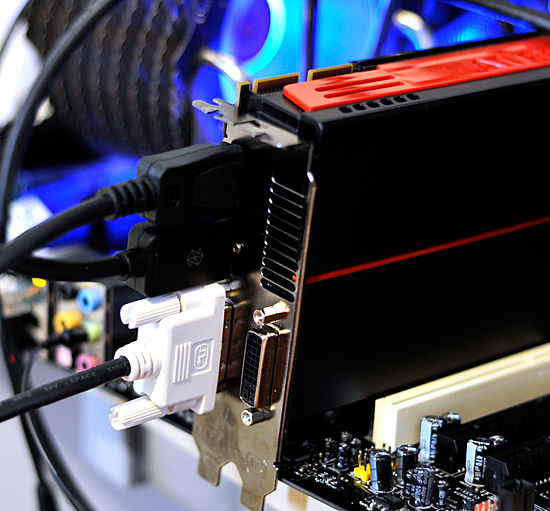
With all three outputs connected, Windows defaults to cloning the display across all monitors. Going into ATI's Catalyst Control Center lets you configure your Eyefinity groups:

With three displays connected I could create a single 1x3 or 3x1 arrangement of displays. I also had the ability to rotate the displays first so they were in portrait mode.

You can create smaller groups, although the ability to do so disappeared after I created my first Eyefinity setup (even after deleting it and trying to recreate it). Once you've selected the type of Eyefinity display you'd like to create, the driver will make a guess as to the arrangement of your panels.

If it guessed correctly, just click Yes and you're good to go. Otherwise ATI has a handy way of determining the location of your monitors:

With the software side taken care of, you now have a Single Large Surface as ATI likes to call it. The display appears as one contiguous panel with a ridiculous resolution to the OS and all applications/games:
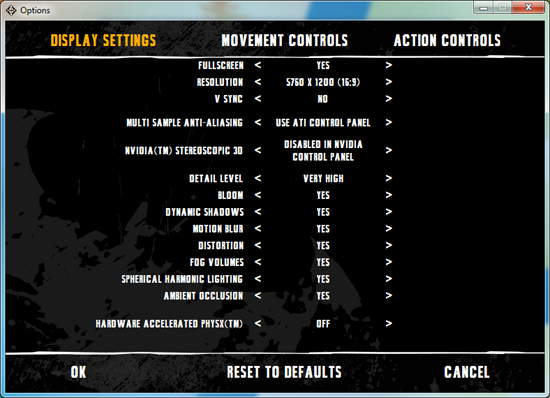
Three 24" panels in a row give us 5760 x 1200
The screenshot above should clue you into the first problem with an Eyefinity setup: aspect ratio. While the Windows desktop simply expands to provide you with more screen real estate, some games may not increase how much you can see - they may just stretch the viewport to fill all of the horizontal resolution. The resolution is correctly listed in Batman Arkham Asylum, but the aspect ratio is not (5760:1200 !~ 16:9). In these situations my Eyefinity setup made me feel downright sick; the weird stretching of characters as they moved towards the outer edges of my vision left me feeling ill.

Dispite Oblivion's support for ultra wide aspect ratio gaming, by default the game stretches to occupy all horizontal resolution
Other games have their own quirks. Resident Evil 5 correctly identified the resolution but appeared to maintain a 16:9 aspect ratio without stretching. In other words, while my display was only 1200 pixels high, the game rendered as if it were 3240 pixels high and only fit what it could onto my screens. This resulted in unusable menus and a game that wasn't actually playable once you got into it.
Games with pre-rendered cutscenes generally don't mesh well with Eyefinity either. In fact, anything that's not rendered on the fly tends to only occupy the middle portion of the screens. Game menus are a perfect example of this:
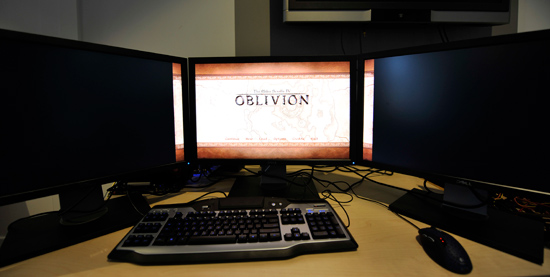
There are other issues with Eyefinity that go beyond just properly taking advantage of the resolution. While the three-monitor setup pictured above is great for games, it's not ideal in Windows. You'd want your main screen to be the one in the center, however since it's a single large display your start menu would actually appear on the leftmost panel. The same applies to games that have a HUD located in the lower left or lower right corners of the display. In Oblivion your health, magic and endurance bars all appear in the lower left, which in the case above means that the far left corner of the left panel is where you have to look for your vitals. Given that each panel is nearly two feet wide, that's a pretty far distance to look.
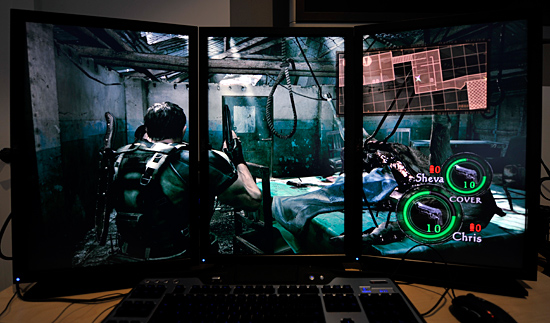
The biggest issue that everyone worried about was bezel thickness hurting the experience. To be honest, bezel thickness was only an issue for me when I oriented the monitors in portrait mode. Sitting close to an array of wide enough panels, the bezel thickness isn't that big of a deal. Which brings me to the next point: immersion.
The game that sold me on Eyefinity was actually one that I don't play: World of Warcraft. The game handled the ultra wide resolution perfectly, it didn't stretch any content, it just expanded my viewport. With the left and right displays tilted inwards slightly, WoW was more immersive. It's not so much that I could see what was going on around me, but that whenever I moved forward I I had the game world in more of my peripheral vision than I usually do. Running through a field felt more like running through a field, since there was more field in my vision. It's the only example where I actually felt like this was the first step towards the holy grail of creating the Holodeck. The effect was pretty impressive, although costly given that I only really attained it in a single game.
Before using Eyefinity for myself I thought I would hate the bezel thickness of the Dell U2410 monitors and I felt that the experience wouldn't be any more engaging. I was wrong on both counts, but I was also wrong to assume that all games would just work perfectly. Out of the four that I tried, only WoW worked flawlessly - the rest either had issues rendering at the unusually wide resolution or simply stretched the content and didn't give me as much additional viewspace to really make the feature useful. Will this all change given that in six months ATI's entire graphics lineup will support three displays? I'd say that's more than likely. The last company to attempt something similar was Matrox and it unfortunately didn't have the graphics horsepower to back it up.
The Radeon HD 5870 itself is fast enough to render many games at 5760 x 1200 even at full detail settings. I managed 48 fps in World of Warcraft and a staggering 66 fps in Batman Arkham Asylum without AA enabled. It's absolutely playable.
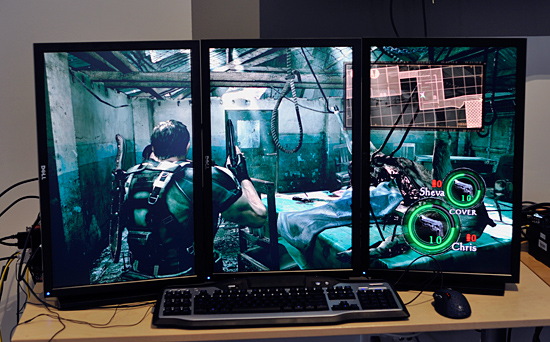










327 Comments
View All Comments
SiliconDoc - Wednesday, September 30, 2009 - link
No, it's the fact you tell LIES, and always in ati's favor, and you got caught, over and over again.That is WHAT HAS HAPPENED.
Now you catch hold of your senses for a moment, and supposedly all the crap you spewed is "ok".
SiliconDoc - Friday, September 25, 2009 - link
Once again, all that matters to YOU, is YOUR games for PC, and ONLY top sellers, and only YOUR OPINION on PhysX.However, after you claimed only 2 games, you went on to bloviate about Havok.
Now you've avoided entirely that issue. Am I to assume, as you have apparently WISHED and thrown about, that HAVOK does not function on NVidia cards? NO QUITE THE CONTRARY !
--
What is REAL, is that NVidia runs Havok AND PhysX just fine, and not only that but ATI DOES NOT.
Now, instead of supporting BOTH, you have singled out your object of HATRED, and spewed your infantile rants, your put downs, your empty comparisons (mere statements), then DEMAND that I show PhysX is worthwhile, with "golden sellers". LOL
It has been 1.5 years or so since Aegia acquisition, and of course, game developers turning anything out in just 6 short months are considered miracle workers.
The real problem oif course for you is ATI does not support PhysX, and when a rouge coder made it happen, NVidia supported him, while ATI came in and crushed the poor fella.
So much for "competition", once again.
Now, I'd demand you show where HAVOK is worthwhile, EXCEPT I'm not the type of person that slams and reams and screams against " a percieved enemy company" just because "my favorite" isn't capable, and in that sense, my favorite IS CAPABLE.
Now, PhysX is awesome, it's great, it's the best there is, and that may or may not change, but as for now, NO OTHER demonstrations (you tube and otherwise) can match it.
That's just a sad fact for you, and with so many maintaining your biased and arrogant demand for anything else, we may have another case of VHS instead of BETA, which of course, you would heartily celebrate, no matter how long it takes to get there.
LOL
Yes, it is funny. It's just hilarious. A few months ago before Mirror's Edge and Anand falling in love with PhysX in it, admittedly, in the article he posted, we had the big screamers whining ZERO.
Well, now a few months later you are whining TWO.
Get ready to whine higher. Yes, you have read about the uptick in support ? LOL
You people are really something.
Oh, I know, CUDA is a big fat zero according to you, too.
(please pass along your thoughts to higher education universities here in the USA, and the federal government national lab research facilites. Thanks)
SiliconDoc - Thursday, September 24, 2009 - link
Yes, another excuse monger. So you basically admit the text is biased, and claim all readers should see the charts and go by those. LOLSo when the text is biased, as you admit, how is it that the rest, the very core of the review is not ? You won't explain that either.
Furthermore, the assumption that competition leads to something better in technology for videocards quicker, fails the basic test that in terms of technology, there is a limit to how fast it proceeds forward, since scientific breakthroughs must come, and often don't come, for instance, new energy technologies, still struggling after decades to make a breakthrough, with endless billions spent, and not much to show for it.
Same here with videocards, there is a LIMIT to the advancement speed, and competition won't be able to exceed that limit.
Furthermore, I NEVER said prices won't be driven down by competition, and you falsely asserted that notion to me.
I DID however say, ATI ALSO IS KNOWN FOR OVERPRICING. (or rather unknown by the red fans, huh, even said by omission to have NOT COMMITTED that "huge sin", that you all blame only Nvidia for doing.)
So you're just WRONG once again.
Begging the other guy to "not argue" then mischaracterizing a conclusion from just one of my statements, ignoring the points made that prove your buddy wrong period, and getting the body of your idea concerning COMPETITION incorrect due to technological and scientific constraints you fail to include, is no way to "argue" at all.
I sure wish there was someone who could take on my points, but so far none of you can. Every time you try, more errors in your thinking are easily exposed.
A MONOPOLY, in let's take for instance, the old OIL BARRONS, was not stagnant, and included major advances in search and extraction, as Standard Oil history clearly testifies to.
Once again, the "pat" cleche' is good for some things ( for instance competing drug stores, for example ), or other such things that don't involve inaccesible technology that has not been INVENTED yet.
The fact that your simpleton attitude failed to note such anomolies, is clearly evidence that once again, thinking "is not reuired" for people like you.
Once again, the rebuttal has failed.
kondor999 - Thursday, September 24, 2009 - link
This is just sad, and I'm no fanboy. I really wanted a 5870, but only with 100% more speed than a GTX285 - not a lousy 33%. Definitely not worth me upgrading, so I guess ATI saved me some money. I'm certain that my 3 GTX280's in Tri-SLI will destroy 2 5870's in CF - although with slightly less compatability (an important advantage for ATI, but not nearly enough).Moricon - Thursday, September 24, 2009 - link
I have been a regular at Tomshardware for a while now, nad keep coming back to Anandtech time and again to read reviews I have already read on other sites, and this one is by far the best I have read so far, (guru3d, toms, firing squad, and many others)The 5870 looks awesome, but from an upgrade point of view, I guess my system will not really benefit from moving on from E7200 @3.8ghz 4gb 1066, HD4870 @850mhz 4400mhz on 1680x1050.
Such a shame that i dont have a larger monitor at the moment or I would have jumped immediately.
Looks like the path is q9550 and 5870 and 1920x1200 monitor or larger to make sense, then might as well go i7, i5, where do you stop..
Well done ATI, well done! But if history follows the Nvidia 3xx chip will be mindblowing compared!
djc208 - Thursday, September 24, 2009 - link
I was most surprised at how far behind the now 2-generation old 3870 is now (at least on these high-end games). Guess my next upgrade (after a SSD) should be a 5850 once the frenzy dies away.JonnyDough - Thursday, September 24, 2009 - link
They could probably use a 1.5 GB card. :(mapesdhs - Wednesday, September 23, 2009 - link
Ryan, any chance you could run Viewperf or other pro-app benchmarks
please? Some professionals use consumer hardware as a cheap way of
obtaining reasonable performance in apps like Maya, 3DS Max, ProE,
etc., so it would most interesting to know how the 5870 behaves when
running such tests, how it compares to Quadro and FireGL cards.
Pro-series boards normally have better performance for ops such as
antialiases lines via different drivers and/or different internal
firmware optimisations. Someday I figure perhaps a consumer card will
be able to match a pro card purely by accident.
Ian.
AmdInside - Wednesday, September 23, 2009 - link
Sorry if this has already been asked but does the 5870 support audio over Display Port? I am holding out for a card that does such a thing. I know it does it for HDMI but also want it to do it for Display Port.VooDooAddict - Wednesday, September 23, 2009 - link
Been waiting for a single gaming class card that can power more then 2 displays for quite some time. (The more then 2 monitors not necessarily for gaming.)The fact that this performs a noticeable bit better then my existing 4870 512MB is a bonus.